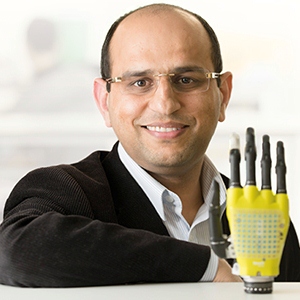I wish the folks at the University of British Columbia (UBC) would include more technical/scientific information in their news releases about research. For those who do like a little more technical information, I included the paper’s abstract at the end of this post.
A March 25, 2019 news item on ScienceDaily trumpets the UBC (Okanagan campus) research,
Researchers at UBC have created the first-ever nanocomposite biomaterial heart-valve developed to reduce or eliminate complications related to heart transplants.
By using a newly developed technique, the researchers were able to build a more durable valve that enables the heart to adapt faster and more seamlessly.
A March 25, 2019 UBC news release (also on EurekAlert) by Patty Wellborn, which originated the news item, gives an accessible description of the ‘new’ valve,
Assistant Professor Hadi Mohammadi runs the Heart Valve Performance Laboratory (HVPL) through UBC Okanagan’s School of Engineering. Lead author on the study, he says the newly developed valve is an example of a transcatheter heart valve, a promising new branch of cardiology. These valves are unique because they can be inserted into a patient through small incisions rather than opening a patient’s chest–a procedure that is generally safer and much less invasive.
“Existing transcatheter heart valves are made of animal tissues, most often the pericardium membrane from a cow’s heart, and have had only moderate success to date,” explains Mohammadi. “The problem is that they face significant implantation risks and can lead to coronary obstruction and acute kidney injury.”
The new valve solves that problem by using naturally derived nanocomposites–a material assembled with a variety of very small components–including gels, vinyl and cellulose. The combination of their new material with the non-invasive nature of transcatheter heart valves makes this new design very promising for use with high-risk patients, according to Mohammadi.
“Not only is the material important but the design and construction of our valve means that it lowers stress on the valve by as much as 40 per cent compared to valves currently available,” says Dylan Goode, a graduate researcher at the HVPL. “It is uniquely manufactured in one continuous form, so it gains strength and flexibility to withstand the circulatory complications that can arise following transplantation.”
Working with researchers from Kelowna General Hospital and Western University, the valve will now undergo vigorous testing to perfect its material composition and design. The testing will include human heart simulators and large animal in-vivo studies. If successful, the valve will then proceed to clinical patient testing.
“This has the potential to become the new standard in heart valve replacement and to provide a safer, longer-term solution for many patients.”
The new design was highlighted in a paper published this month in the Journal of Engineering in Medicine with financial support from the Natural Sciences and Engineering Research Council of Canada [NSERC] .
Here’s a link to and a citation for the paper,
Proposed percutaneous aortic valve prosthesis made of cryogel by Hadi Mohammadi, Dylan Goode, Guy Fradet, Kibret Mequanint. Proceedings of the Institution of Mechanical Engineers, Part H: Journal of Engineering in Medicine, 2019; 095441191983730 DOI: 10.1177/0954411919837302 First Published March 20, 2019
This paper is behind a paywall.
As promised, here’s the abstract,
Transcatheter heart valves are promising for high-risk patients. Generally, their leaflets are made of pericardium stented in a Nitinol basket. Despite their relative success, they are associated with significant complications such as valve migration, implantation risks, stroke, coronary obstruction, myocardial infraction, acute kidney injury (which all are due to the release of detached solid calcific pieces in to the blood stream) and expected issues existing with tissue valves such as leaflet calcification. This study is an attempt to fabricate the first ever polymeric percutaneous valves made of cryogel following the geometry and mechanical properties of porcine aortic valve to address some of the above-mentioned shortcomings. A novel, one-piece, tricuspid percutaneous valve, consisting of leaflets made entirely from the hydrogel, polyvinyl alcohol cryogel reinforced by bacterial cellulose natural nanocomposite, attached to a Nitinol basket was developed and demonstrated. Following the natural geometry of the valve, a novel approach was applied based on the revolution about an axis of a hyperboloid shape. The geometry was modified based on avoiding sharp warpage of leaflets and removal of the central opening orifice area of the valve when valve is fully closed using the finite element analysis. The modified geometry was replaced by a cloud of (control) points and was essentially converted to Bezier surfaces for further adjustment. A cavity mold was then designed and fabricated to form the valve. The fabricated valve was sewn into the Nitinol basket which is covered by Dacron cloth. The models presented in this study merit further development and revisions for both aortic and mitral positions.
So, this new valve partially consists of bacterial cellulose and the design is based on porcine (pig) valves. Cellulose is the most abundant organic material on earth and if it forms part of the nanocomposite, I’d expect to see the word ‘nanocellulose’ mentioned somewhere. What puzzles me is the ‘bacterial cellulose’, a term that is unfamiliar to me. Anyone who cares to clarify the matter for me, please feel free to leave a comment.
Regarding the pig valve, I understand that heart patients who require valves have a choice of a pig valve or a mechanical valve. Apparently, people with porcine valves don’t need to take drugs to counteract rejection amongst other advantages but the valves do have a shorter life span (10 to 15 years) in addition to the other shortcomings mentioned in the abstract.
Assuming I properly understand the abstract, this ‘nanocomposite’ valve could combine the advantages of the mechanical and porcine valves while offering more durability than either one.
Again, should anyone care to increase my understanding of the valves and the advantages of this new one, please do leave a comment.
